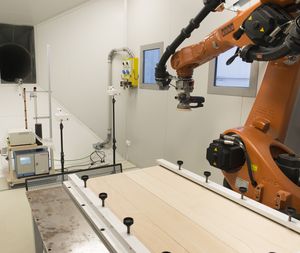KANBrief 2/18

Emissions of wood or silica dust from new hand-held electric tools are measured with reference to standardized test methods. These methods have certain limits however, resulting in constraints upon their repeatibility. INRS, the French occupational safety and health institute, proposes a different test method that would enable different machines to be classified for the same work process according to the level of the dust emissions.
The European Committee for Electrotechnical Standardisation (CENELEC) has set up a working group, TC 116/WG 04, which is developing specific Type C standards (the EN 50632 series) describing methods for the measurement of wood or silica dust emissions from hand-held electric tools. Parties represented on this standards committee are primarily machinery manufacturers (Bosch, Stanley Black and Decker, Hilti, Makita, Hitachi, Festool, Metabo, Fein, Varo, etc.) and test and certification bodies (SGS, Intertek, VDE Testing, etc.). The INRS is involved in this working group in order to contribute its expertise in the measurement of dust emissions from machines.
The measurement methods concern dust emissions from woodworking machines such as circular saws, grinding machines, routers, planes and jigsaws, and silica dust emissions from drills, grinding machines and angle grinders. A specific test procedure was set out for each of these machine types. Each test cycle lasts at least half an hour and must be repeated several times in order for a mean value for the dust concentration to be obtained at the end of the procedure.
At present, the tests entail persons performing certain work tasks repeatedly for each machine type. The dust emissions are measured in the test at two fixed points on the body of the machine operator. The measurements are conducted in a non-ventilated test room to EN 1093-9: Safety of machinery – Evaluation of the emission of airborne hazardous substances – Part 9: Pollutant concentration parameter, room method. This standard was originally developed for dust concentration measurements around machines with local exhaust ventilation equipment possessing a flow rate of over 500 m3 per hour.
In accordance with the provisions of the test standard, the measurements are performed on hand-held electric tools that are connected to mobile vacuuming equipment, which collects the dust. During the course of the test cycles however, the filters and collecting bags become increasingly filled with dust, causing the rated collection rate (which describes the vacuuming equipment in its new condition) to change. This collection rate is therefore neither constant, nor measurable and controllable during the test, although it should in fact constitute a significant measurement variable for the reliability with which dust at the machine is collected. In addition, the mobile vacuuming equipment blows air into the test room during operation, as a result of which the measured concentration may fluctuate. It must therefore be concluded that the values measured on the body of the machine operator during these test cycles serve only as an indication, and can by no means be compared to an exposure measurement. They do not indicate the actual level of dust emissions from the machine, since this is influenced by the operator (physique, posture, movements, etc.). These specific aspects have an influence upon the dust concentration measurements, and impair the repeatability of the test results.
The INRS proposes that the same method be used for the tests, but that the different test cycles be performed by a robot. The use of a fully automated test room leads to greater repeatability of the measurement results and, in particular, avoids exposure of the tester to carcinogenic, mutagenic and reprotoxic substances during performance of the test. Only the pollutants emitted directly by the machine (the tests were performed only for wood dust) are measured, and the vacuuming equipment for chips and dust is located outside the test room. This vacuuming system is calibrated to each machine, resulting in the dust exhaust flow rate being known and constant for all tests. The measurements are performed in a ventilated test room to EN 1093-3: Safety of machinery – Evaluation of the emission of airborne hazardous substances – Part 3: Test bench method for the measurement of the emission rate of a given pollutant.
This method was developed for the measurement of pollutant emissions from machines, and enables different machines intended for identical work tasks to be divided into classes. The INRS is contributing its expertise by participating in standardization work in TC 116/WG 04 in order to merge these two test methods and to enable pollutant emissions from hand-held electric tools to be measured more safely and reliably in the future.
Further information on the INRS study.
François-Xavier Keller
francois-xavier.keller@inrs.fr